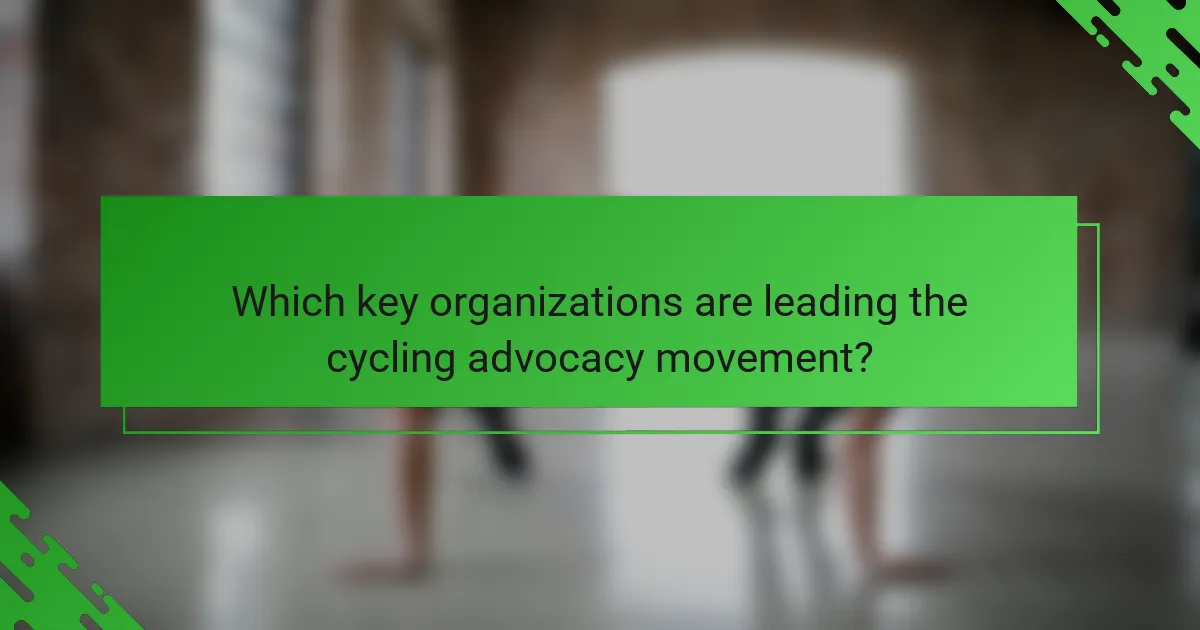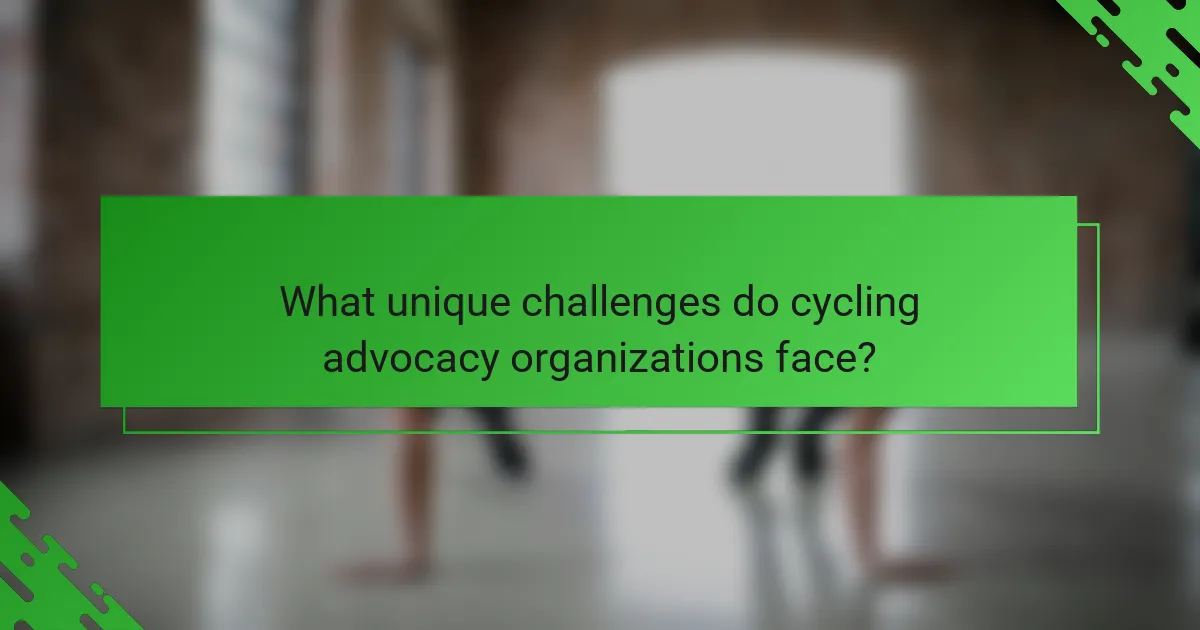Cycling advocacy plays a crucial role in promoting cycling as a sustainable mode of transport. Key organizations work to improve cycling infrastructure, enhance safety, and influence policy. Achievements include increased funding for bike lanes, successful public awareness campaigns, and community engagement initiatives. Challenges such as funding limitations and political resistance continue to affect the movement’s progress.

What are the primary goals of cycling advocacy organizations?
Cycling advocacy organizations primarily aim to promote cycling as a sustainable mode of transport, improve cycling infrastructure, and enhance safety for cyclists. They work to influence policy, raise public awareness, and encourage community engagement. Key goals include increasing ridership, advocating for better laws, and fostering a culture that supports cycling. Achievements often involve successful campaigns for bike lanes, improved traffic laws, and educational programs on cycling safety.
How do these goals vary across different regions?
Cycling advocacy goals vary significantly across regions due to cultural, economic, and infrastructural differences. For instance, urban areas may prioritize infrastructure development, while rural regions focus on safety and accessibility.
| Region | Primary Goal | Unique Focus |
|—————–|———————————|———————————-|
| North America | Infrastructure improvement | Bike lane expansion |
| Europe | Sustainability and integration | Multi-modal transport solutions |
| Asia | Safety and awareness | Education on cycling benefits |
| Africa | Accessibility and affordability | Community engagement |
| Australia | Health promotion | Recreational cycling initiatives |
What impact do these goals have on local cycling communities?
Cycling advocacy goals significantly enhance local cycling communities by promoting safer infrastructure and increased participation. These initiatives lead to improved cycling conditions, fostering a sense of community and encouraging healthier lifestyles. Advocacy efforts often result in better funding for bike lanes and educational programs, which further support cycling culture. As a result, local cycling communities experience growth in membership and engagement, creating a more vibrant and connected environment for all cyclists.

Which key organizations are leading the cycling advocacy movement?
Key organizations leading the cycling advocacy movement include the League of American Bicyclists, PeopleForBikes, and the International Mountain Bicycling Association. These organizations aim to promote cycling safety, infrastructure development, and policy changes.
The League of American Bicyclists focuses on national advocacy and education, supporting local cycling groups across the U.S. PeopleForBikes works on a broader scale, advocating for better cycling conditions and funding for bike-related projects. The International Mountain Bicycling Association emphasizes trail access and sustainable practices for mountain biking communities.
These organizations achieve their goals through campaigns, partnerships, and community engagement, significantly influencing cycling policies and public perception. Their collective efforts enhance cycling infrastructure and promote a culture of cycling as a viable transportation option.
What roles do national organizations play compared to local groups?
National organizations typically focus on broad policy advocacy and funding, while local groups prioritize community engagement and grassroots initiatives. National organizations like the League of American Bicyclists advocate for legislation and provide resources to local chapters. In contrast, local groups often organize events, promote cycling safety, and address specific regional issues. This division allows for a comprehensive approach to cycling advocacy, where national goals are supported by localized efforts.
How do these organizations collaborate for greater impact?
Organizations collaborate through shared goals, resource pooling, and coordinated campaigns to enhance cycling advocacy. They unite to promote infrastructure improvements, safety initiatives, and public awareness. For instance, partnerships between local advocacy groups and national organizations amplify their reach and impact. Collaborative events, such as community rides and educational workshops, foster engagement and support for cycling initiatives. This teamwork leads to significant achievements in promoting cycling as a viable transportation option, ultimately benefiting public health and the environment.

What achievements have cycling advocacy organizations made in recent years?
Cycling advocacy organizations have made significant achievements in recent years, including increased funding for bike infrastructure and expanded public awareness campaigns. These organizations have successfully lobbied for policies promoting cycling safety and accessibility. For instance, the League of American Bicyclists reported a 30% increase in protected bike lanes across major cities. Additionally, advocacy groups have collaborated with local governments to implement bike-sharing programs, enhancing urban mobility. These efforts have contributed to a rise in cycling participation, fostering healthier communities and reducing traffic congestion.
How have these achievements influenced public policy?
Cycling advocacy has significantly influenced public policy by promoting sustainable transportation and health initiatives. Organizations like the League of American Bicyclists and PeopleForBikes have successfully lobbied for improved infrastructure, resulting in increased funding for bike lanes and safety programs.
These achievements have led to policy changes that prioritize cycling in urban planning. For instance, cities like Copenhagen and Amsterdam have implemented extensive cycling networks, demonstrating the impact of advocacy on local governance.
As a result, public health has improved, with reduced traffic congestion and lower emissions. Cycling advocacy continues to shape policies that support eco-friendly transportation and enhance community well-being.
Which specific campaigns have been particularly successful?
Several cycling advocacy campaigns have achieved notable success, including “Cities for Cycling,” “Bike to Work Day,” and “National Bike Month.” These initiatives have increased cycling participation and improved infrastructure.
“Cities for Cycling” focuses on enhancing urban cycling conditions, resulting in improved safety and accessibility. “Bike to Work Day” promotes commuting by bicycle, encouraging thousands to choose cycling over driving. “National Bike Month” raises awareness and celebrates cycling, fostering community engagement and support for cycling-related policies.
These campaigns demonstrate the effectiveness of advocacy efforts in promoting cycling as a sustainable mode of transportation.

How does cycling advocacy address safety concerns for cyclists?
Cycling advocacy directly addresses safety concerns for cyclists by promoting infrastructure improvements and policy changes. Organizations advocate for dedicated bike lanes, improved road signage, and stricter traffic laws. These measures aim to reduce accidents and enhance visibility for cyclists. For example, cities that have implemented comprehensive cycling plans report a significant decrease in cyclist injuries. Advocacy efforts also include community education programs that raise awareness about cyclist rights and responsibilities, fostering a safer environment.
What initiatives are in place to improve cycling infrastructure?
Various initiatives aim to enhance cycling infrastructure, driven by advocacy organizations with specific goals. Key organizations like the League of American Bicyclists focus on policy change, education, and community engagement. They promote the development of safe bike lanes, improved signage, and secure parking facilities. Additionally, local advocacy groups often collaborate with city planners to identify and address gaps in existing infrastructure. Achievements include increased funding for cycling projects and the establishment of more comprehensive bike-sharing programs. These efforts collectively contribute to a safer, more accessible cycling environment.
How do advocacy efforts promote road safety education?
Advocacy efforts enhance road safety education by raising awareness, influencing policy, and promoting safe cycling practices. Organizations like the League of American Bicyclists and PeopleForBikes focus on education initiatives, community engagement, and legislative advocacy. These efforts lead to improved infrastructure and safer environments for cyclists, ultimately reducing accidents and fatalities. As a result, cycling advocacy plays a crucial role in fostering a culture of safety on the roads.

What unique challenges do cycling advocacy organizations face?
Cycling advocacy organizations face challenges such as funding limitations, political resistance, and public awareness. These obstacles hinder their ability to promote cycling infrastructure and safety effectively. For instance, securing government support often requires overcoming bureaucratic hurdles and competing interests. Additionally, misinformation about cycling can diminish public support, complicating efforts to increase cycling participation and improve urban planning.
How do funding and resource limitations affect their initiatives?
Funding and resource limitations significantly hinder cycling advocacy initiatives. These constraints restrict outreach efforts, limit educational programs, and reduce the capacity for impactful campaigns. Organizations often struggle to maintain staff and resources, which affects their ability to influence policy and promote cycling infrastructure. Consequently, advocacy goals may remain unmet, delaying progress toward sustainable transportation solutions.
What strategies do organizations use to overcome these challenges?
Organizations employ various strategies to overcome challenges in cycling advocacy. They collaborate with local governments to improve infrastructure, advocate for policy changes, and engage communities through educational programs. Additionally, they leverage social media campaigns to raise awareness and build support. These efforts aim to create safer cycling environments and promote cycling as a viable transportation option.

Why is community engagement crucial for successful cycling advocacy?
Community engagement is vital for successful cycling advocacy as it fosters collaboration and amplifies voices. Engaged communities drive awareness, influence policy, and create safer cycling environments. For example, advocacy groups that involve local cyclists can better address specific needs and concerns. These organizations often achieve greater impact through grassroots efforts, leading to improved infrastructure and increased cycling participation. Engaging diverse community members ensures representation and enhances the effectiveness of advocacy campaigns.
How do organizations build relationships with local cyclists?
Organizations build relationships with local cyclists through community engagement, advocacy efforts, and collaboration on cycling initiatives. They host events, provide resources, and foster communication channels.
Active outreach programs, such as group rides and workshops, create a sense of community. Organizations often partner with local businesses to promote cycling-friendly practices. These collaborations enhance visibility and support for cycling infrastructure improvements.
Advocacy goals focus on safety, accessibility, and sustainability. By aligning with cyclists’ needs, organizations can effectively influence local policies. Achievements include increased bike lanes and community cycling events, which strengthen ties with local cyclists.
What methods are effective in raising public awareness?
Effective methods for raising public awareness include community engagement, educational campaigns, and partnerships with local organizations. These strategies help promote the benefits of cycling and advocate for infrastructure improvements. For example, hosting community rides increases visibility and fosters a sense of community among cyclists. Additionally, utilizing social media platforms amplifies messaging and reaches a broader audience, enhancing advocacy efforts. Engaging local schools in cycling programs can also instill cycling culture in younger generations, creating long-term awareness and support for cycling initiatives.

What role does technology play in cycling advocacy today?
Technology plays a crucial role in cycling advocacy by enhancing communication, data collection, and community engagement. Digital platforms allow organizations to share information and mobilize support effectively. For instance, social media campaigns raise awareness about cycling safety and infrastructure needs. Additionally, data analytics tools help advocates assess cycling patterns and identify areas for improvement. The integration of technology fosters collaboration among stakeholders, driving policy changes and promoting sustainable transportation solutions.
How are digital platforms used to mobilize support?
Digital platforms mobilize support for cycling advocacy by facilitating community engagement, information sharing, and fundraising. Organizations like the League of American Bicyclists and PeopleForBikes leverage social media, websites, and apps to connect cyclists and advocates. These platforms amplify campaigns, organize events, and promote policy changes. For instance, social media campaigns can rapidly spread awareness of local cycling issues, gathering public support and driving action.
What innovative tools are being developed to assist advocacy efforts?
Innovative tools being developed for cycling advocacy include mobile apps, data analytics platforms, and social media campaigns. These technologies enhance community engagement, track cycling infrastructure, and promote safe cycling practices. For instance, apps like Strava and Komoot provide cyclists with route planning and community features, fostering collaboration among users. Data analytics tools help organizations assess cycling patterns, guiding policy improvements. Social media campaigns amplify advocacy messages, reaching broader audiences and mobilizing support for cycling initiatives.
What best practices can organizations adopt for effective advocacy?
Organizations can adopt several best practices for effective cycling advocacy. First, they should build strong coalitions with local stakeholders, including community groups and government agencies. This collaboration enhances credibility and expands outreach.
Second, utilizing data to highlight the benefits of cycling, such as reduced traffic congestion and improved public health, can strengthen advocacy efforts. Presenting compelling statistics can influence policy decisions.
Third, engaging in grassroots campaigns raises awareness and encourages community involvement. Organizing events like bike rides or workshops fosters a sense of community and promotes cycling as a viable transportation option.
Finally, continuous communication with policymakers is essential. Regular updates on advocacy goals and achievements can keep cycling initiatives on their radar, ensuring sustained support.



